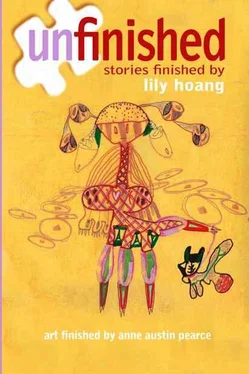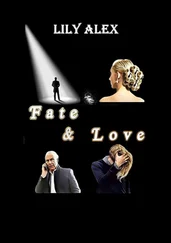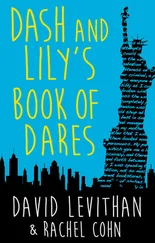Lily Hoang - Unfinished - stories finished by Lily Hoang
Здесь есть возможность читать онлайн «Lily Hoang - Unfinished - stories finished by Lily Hoang» весь текст электронной книги совершенно бесплатно (целиком полную версию без сокращений). В некоторых случаях можно слушать аудио, скачать через торрент в формате fb2 и присутствует краткое содержание. Издательство: Jaded Ibis Press, Жанр: Современная проза, на английском языке. Описание произведения, (предисловие) а так же отзывы посетителей доступны на портале библиотеки ЛибКат.
- Название:Unfinished: stories finished by Lily Hoang
- Автор:
- Издательство:Jaded Ibis Press
- Жанр:
- Год:неизвестен
- ISBN:нет данных
- Рейтинг книги:5 / 5. Голосов: 1
-
Избранное:Добавить в избранное
- Отзывы:
-
Ваша оценка:
- 100
- 1
- 2
- 3
- 4
- 5
Unfinished: stories finished by Lily Hoang: краткое содержание, описание и аннотация
Предлагаем к чтению аннотацию, описание, краткое содержание или предисловие (зависит от того, что написал сам автор книги «Unfinished: stories finished by Lily Hoang»). Если вы не нашли необходимую информацию о книге — напишите в комментариях, мы постараемся отыскать её.
Unfinished: stories finished by Lily Hoang — читать онлайн бесплатно полную книгу (весь текст) целиком
Ниже представлен текст книги, разбитый по страницам. Система сохранения места последней прочитанной страницы, позволяет с удобством читать онлайн бесплатно книгу «Unfinished: stories finished by Lily Hoang», без необходимости каждый раз заново искать на чём Вы остановились. Поставьте закладку, и сможете в любой момент перейти на страницу, на которой закончили чтение.
Интервал:
Закладка:
Her mother was impressed with her daughter’s self-knowledge.
Then, almost as though she were passing a torch, she told her daughter how she made her fortune.
For all of Pony’s life, she’s assumed her parents were rich because her father owned a candy factory, and sure, that brought in millions, but the real money came from her mother.
Then, Pony remembered Pony, how easy it was, the pure pleasure. And for the first time in a long time, she felt satisfaction.
Of course, what was most fulfilling about her mother’s occupation was that no one else but Pony knew about it. Her father didn’t know. He’d simply assumed it was money from her inheritance. “It’s better that way,” her mother assured.
So Pony began killing for hire.
And she has been doing it for years. It’s the most worthwhile thing she can imagine doing. Except, of course, that she does not retain the actual experience of murder.
Her least favorite method of killing is by gun. That’s just plain boring.
Pony says, “Why is that I’m not fully conscious when I kill someone?”
Her mother says, “Hm?”
Pony says, “I mean, I know I’m doing it. Then, it’s done and I know I did it. Killed, I mean. But I’m not actually in control. I don’t say: Hand, do this. Use more force, arm.”
Her mother says, “Hm.”
Her mother says, “It takes time.”
She says, “What takes time?”
Her mother says, “Fully coming to terms with what you’re doing.”
She says, “I have no problem with killing.”
She clarifies, “I enjoy it. I wish I could enjoy it more.”
Her mother says, “Why don’t have you a problem with killing?”
Pony says, “You’re getting off topic.”
Pony says, “How can I enjoy it more?”
Her mother says, “Is it because of me?”
Pony says, “What?”
Her mother says, suddenly aware of the conversation they were having, “Sorry, dear. I really must get some sleep.”
Once, when Pony became angry with her mother, she decided she would start her own business. She made flyers with little brown and white spotted ponies dancing on a hillside. Along the blue, cloudless sky, she wrote, “Pony For Hire: Kill & Clean.” At the bottom, she put her cell phone and email address.
She got several jobs this way, but it wasn’t the same. There was something about working with her mother that proved satisfying, even if they never technically worked together.
She also likes medieval weapons. If she could, Pony would torture as well, but she can’t, unless the client specifically requests it. There are rules.
Pony and her mother kill all kinds of people. When clients contact them, they never ask for reasons. They never ask for details. They only want to know a name and if there’s a preferred place for the murder to take place. Also, and perhaps most importantly, what the client would like the soon-to-be deceased to look like: a suicide, murder, accidental death, etc.
Pony’s mother takes all the clean kills. Pony makes a big mess.
Making a mess is much more fun.
The first few kills, her mother supervised. She wasn’t in the room or anything. She stayed in a car about a mile away, just in case Pony needed help.
She didn’t. Except with cleaning.
Then Pony did jobs by herself entirely.
Although as a rule, she hates cleaning, but like a person who washes dishes after a big dinner, she gets to experience each step of her process all over again. She can wipe off each blade, measure how far the blood puddles, inspect the room for bits of intestines.
But no matter how fulfilling it can to be re-experience the original experience while cleaning, it is not substitute for the real thing, which she cannot remember.
For a while, Pony tried therapy.
But she never felt she could be fully open with him. Mostly because she understood that legally, doctor-patient confidentiality ends when either crimes are committed or people — whether self or others — could potentially be harmed.
And she definitely harms people.
That is, if dead people are still people.
But she certainly has intentions of harm.
Needless to say, the therapy didn’t work.
So now, as Pony stands with her back against the stainless steel, energy-efficient refrigerator, she is at a crossroads. She can either continue her life as is — enjoyable although ultimately unfulfilling — or she can quit. She can do something else like become a nurse and care for sick little babies.
The dead man’s blood pools at her sneakers, and Pony giggles like she hasn’t giggled since her pony died.
the museum of oddities and eccentricities (from John Madera)
I.
The Museum of Oddities and Eccentricities uses static electricity for power. Very little light or energy can be generated this way, but the curators do not mind. Besides, the glass ceiling lets in ample light.
The museum itself does not need to be seen.
Or, at least, what exists inside the Museum does not need to be seen.
Even if its exhibits are seen, they are often not believed. They are regarded as jokes or frauds. They are unreal, that is, the real that is right before your eyes.
The exhibits invite loss. They encourage time to tinker, an alternation between hallucination and delusion. In the Museum, there is no right or wrong, which is probably the most difficult thing to get right. The exhibits create a mishmash of fantasy, for empty stretches of space.
Visitors may take something away and/or have something taken away from them. Ideally, a visitor learns to bridge this gap. But some walk away with imploding or exploding hearts. Some leave with a head full of empty chatter. Some emerge unbeing. Some leave with hard information that can never be shared.
The Museum finds that using absurd objects, or objects that demonstrate absurdity, is by far more interesting to interact with than dioramas, models, pictures, etc., that simply explain a particular phenomenon. In other words, if there is no way to have absurd objects and/or to be able to interact with absurd phenomena, then perhaps the idea is unsuitable for exhibition. The Museum understands that not every idea brings delight.
As seeing and belief do not always dovetail here, other senses often come dramatically into play. Many of the exhibits are interactive, meaning they may be touched or they may touch. But visitors should resist the impulse. Static electricity runs through the entire institution. Touching anything runs the risk of transference, in the Freudian sense, of course.
To think: this all began as a floating island of garbage.
II.
This does not happen often, but some children, particularly those who do not honor the donation policy (all persons must give a wish), find a transference of oddity when they touch certain displays.
The first donation to the Museum was a hand. Maggie changed the floating island into a garden grove.
III.
Glass ceilings were added to the Museum in the early twentieth century, when the Museum received a rather large donation.
Of course, even though the donation was pseudonymous, everyone knows who the patron is. At the Museum of Oddities and Eccentricities (at least in the eyes of its curators), there has only ever been one donor, one patron, its god of sorts: Gretchen. As Gretchen’s first donation brought the Museum to its present form, all previous donations are considered insignificant.
IV.
On Good Fridays, Curator 1502 plays his euphonium in the blackened tarmac room. His instrument’s name comes from the Greek word meaning ‘beautiful sounding,’ or at least that’s what he’d heard from someone who knew someone who knew Greek, Ancient not Modern.
Читать дальшеИнтервал:
Закладка:
Похожие книги на «Unfinished: stories finished by Lily Hoang»
Представляем Вашему вниманию похожие книги на «Unfinished: stories finished by Lily Hoang» списком для выбора. Мы отобрали схожую по названию и смыслу литературу в надежде предоставить читателям больше вариантов отыскать новые, интересные, ещё непрочитанные произведения.
Обсуждение, отзывы о книге «Unfinished: stories finished by Lily Hoang» и просто собственные мнения читателей. Оставьте ваши комментарии, напишите, что Вы думаете о произведении, его смысле или главных героях. Укажите что конкретно понравилось, а что нет, и почему Вы так считаете.






![О Генри - Неоконченный рассказ [An Unfinished Story]](/books/415443/o-genri-neokonchennyj-rasskaz-an-unfinished-story-thumb.webp)





